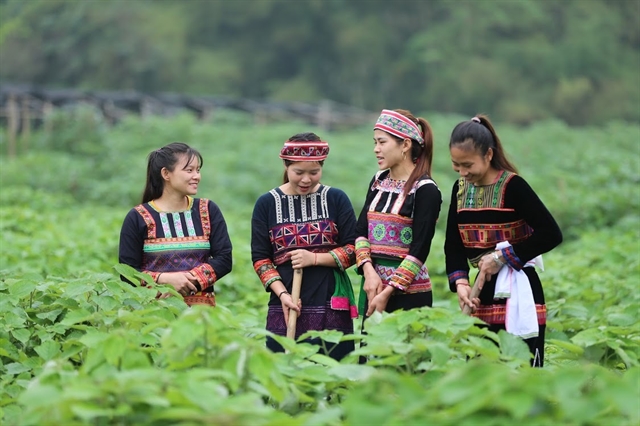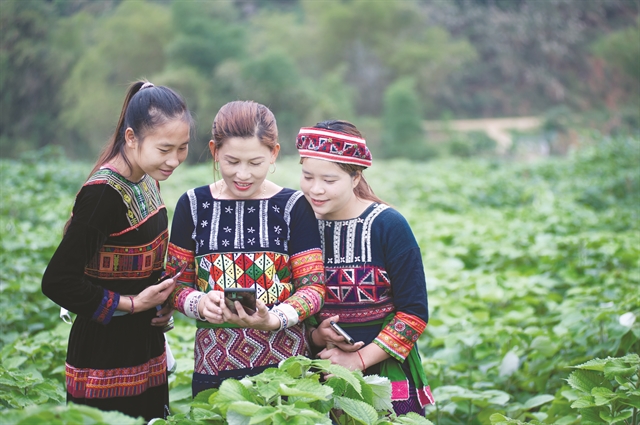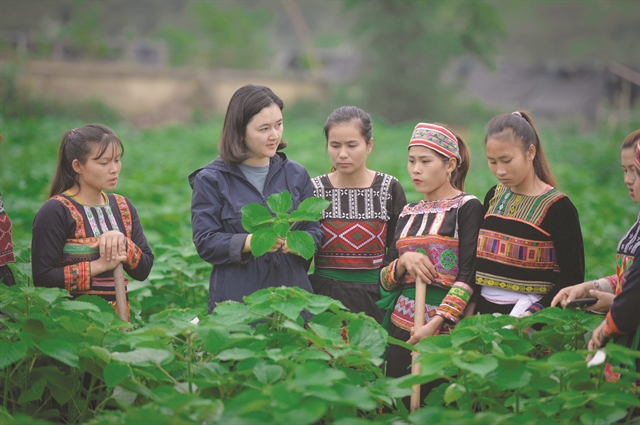By Lê Hương
A light rain falls early on a cool spring morning. The field of ramie (a type of nettle with fibrous stems) in Đồng Vệ Village seems fresher from the moisture.
Lương Thị Đàn, 33, from the Xa Phó ethnic minority group, works her land with a keen eye, clearing away wild grass from the roots of the ramie and sometimes picking little worms off the leaves.
She loses herself in what has been a daily task for the last two years.
Nearby, her husband, Vũ Văn Toán, 40, works a hoe on a bare plot of land. He will soon seed new ramie in the ground.

LIFE CHANGER: Local women can earn stable incomes from growing ramie. VNS Photo Nguyễn Nam
The couple chat with their children from time to time.
Incredibly, just two years prior they spent almost the whole year working elsewhere, sometimes apart from each other, while their children stayed with their grandparents.
“We barely made ends meet here, so we had to find work wherever we could and send money home for my parents to raise our children,” said Đàn.
At the end of 2018, many women in Đồng Vệ Village, Chiềng Ken Commune, in Văn Bàn District, northern Lào Cai province, began talking about how planting ramie was easy and brought in a good income, and the couple decided to stay home and see if it was indeed possible.

TROUBLE-FREE: Growing ramie really is quite simple. VNS Photo Vũ Châu Ngọc
“The income from planting ramie is four or five times higher than from planting rice, corn, or cassava,” Đàn said. “We earned about VNĐ40 million [US$1724] for each hectare last year. That meant we could stay at home and spend more time taking care of our children and my parents, who are getting old and frail.”
She was even able to repair her dilapidated house and buy some new furniture and things like a fridge, a TV, and a motorbike.
“I feel content now with my work and life,” she said. “At last, we can earn a stable income in our homeland and enjoy life with our children and families.”
Đàn is one of hundreds of women from ethnic minority groups to benefit from a project entitled Developing the Value Chain for Ramie by Women in Văn Bàn District, carried out in ten communes between 2018 and 2021 by the local women’s union, the An Phước Textile Company, and the GREAT (Gender Responsive Equitable Agriculture and Tourism) Program supported by the Australian Government.
According to Trần Văn Liên, chairman of the local Gia Lan Agriculture, Forestry, and Environmental Services Cooperative, ramie is quite easy to invest in compared to other crops.

READY TO GO: Ramie can be harvested a mere 3 months after being planted. VNS Photo Nguyễn Nam
“You need only invest in the seedlings and fertiliser initially, which cost about VNĐ25 million per ha, care for the crop for three months, and then harvest it every 45-60 days for a period of ten years,” he said. “It then needs to be replanted. So, each year there are five or six harvests, with earnings reaching VNĐ100 million per ha per year.”
He was among the first in the district to try and grow the plant. Upon seeing the results, he joined with staff from the local women’s union to knock on every door to persuade people to plant ramie.
“It was difficult at first, as people had been disappointed many times before after being persuaded to switch crops,” he said. “Projects introducing crops like tomato and turmeric all failed, as there were no links between farmers and wholesalers. People became wary of new projects, and only believed me when I told them I had done it myself and earned a lot more money.”
From a handful of households in the village making the change, there are now 30 households involved. The cooperative buys seeds from An Phước, nurtures the seedlings, then sells them to farmers. When they harvest, they sell the ramie stems to the collective, who then send it on to the company for further processing.
The total growing area in the district now stands at some 50 ha belonging to 171 households, including 332 women, most of whom are from the Tày, Dao, Mông, and Xa Phó ethnic minority groups.
Đàn said she and her husband were trained by specialists from Hà Nội, together with other farming families.
“We, the ramie planting team in the village, were given watering equipment and processing machines to lessen the workload,” she said.
The farmers have no concerns about their crop, as the company has committed to buy all of their harvest for the next ten years.

AT HOME: Growing ramie creates many jobs for local women. VNS Photo Nguyễn Nam
“We sell the stems to the company for weaving fabric, while the leaves can be used to make bánh gai (dumplings), or as cattle feed or for planting mushrooms, and the roots can be sold to make herbal medicine,” she said.
Nguyễn Thị Quyên, who works at the women’s union, said they very much appreciated GREAT’s support.
“We have joined hands with other agencies to implement similar projects to improve incomes for local people, but GREAT is the first partner to provide skills training to farmers and to combine gender training to help women become more confident and encourage men to pay more attention to sharing the housework,” she said.
"In other projects, farmers are only given information and little else. It’s rare to receive the training and close support GREAT provides," she added.
Local women now make their opinions heard more often at community meetings.
“Prior to the project getting underway, if both the husband and wife attended a community meeting, only the husband would speak,” Quyên said.
The local weather and soil conditions were a factor in growing ramie, as specialists from An Phước confirmed that productivity and quality would be higher here than in other areas around the country and even in China, where the seedlings originated.
“We are already seeing substantial growth but it really needs to be taken to the next level,” said Phil Harman, Team Leader of the GREAT Program, “The sector needs additional investment, especially in seedling production, and further support in logistics and training.”
The fibre from the ramie stems is much sought after by textile companies around the world, particularly because of its strength, which makes it suitable for products like parachutes.
Trần Thị Việt, Deputy Secretary of the Văn Bàn District Party Committee, said that after two years of implementing the GREAT project, the lives of local women had been greatly improved.
“Earning a stable income gives them the opportunity to better take care of themselves and their families, teach their children, and no longer be forced to leave home and seek work elsewhere,” she said.
The women’s union expects to expand the ramie planting area to 500 ha, providing stable incomes to 3,550 women from ethnic minority groups. VNS

FAMILY-FRIENDLY: Nguyễn Thị Quyên, (second from left), from the local women's union, often visits women working in the ramie fields to stay abreast of the crop situation. VNS Photo Vũ Châu Ngọc
OVietnam